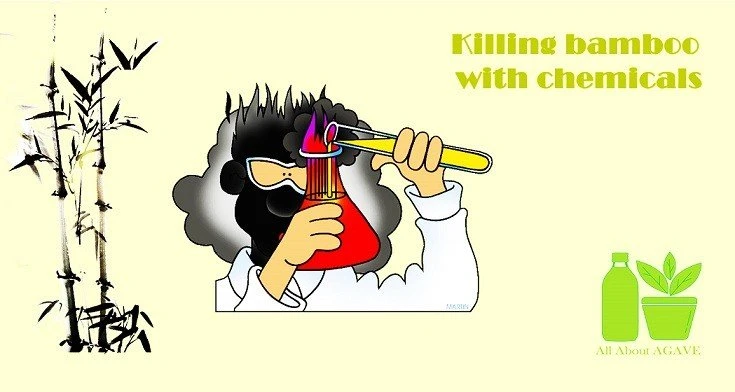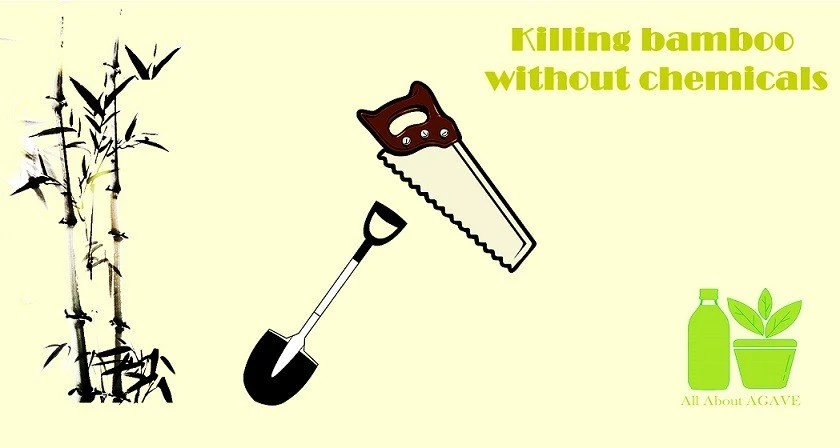reviewed by Christina Lopez
Bamboo is a member of the grass family and is quite invasive. Any space bamboo can flourish; it will take over if left alone. If you need to control the spread of bamboo or eliminate it, be prepared for a long, hard fight. Bamboo is very persistent and will do everything to resist your efforts to kill it.
There are two ways you can go about killing bamboo. The first is to use chemicals, while the second approach is to use your garden tools.
Let's start with the chemical approach.
Contents

As weird as it may sound, you must enable the bamboo to regrow after cutting it down or mowing it to the ground. This way, you can then use your herbicide to spray or paint it. If you try to apply herbicide to mature bamboo, you are wasting your time. Instead, you could time your bamboo cutting for late winter so that by the time new growth arrives in late spring or early summer, you can apply the herbicide.
As soon as you see a new shoot emerges, cut away the rhizomes (stems) that grow underground. Use a sharp shovel or garden implement to do the job. Also, remove as many clumps of roots as you can. You will have to dig deep for the roots as they are known to grow from around two feet underground. Follow the root network, which travels horizontally across the area. Dig out as much as possible even as you apply herbicide to the bamboo shoots.

Glyphosate herbicide is a powerful agent that kills any plant with which it comes into contact. So, it would be best if you were careful that you apply this herbicide only to the bamboo shoot, leaves, and stalks. Allow enough time for the herbicide to penetrate the plant. Unless you are told to do so, avoid applying this herbicide to the soil surrounding the bamboo. This application does not work. Also, be careful with the herbicide if the bamboo you want to kill is close to any water supply source like a lake or river. Avoid contaminating the water.
An alternative is to chop down the bamboo and apply a stump and root-killing solution containing glyphosate or triclopyr to the regrowing foliage.
Unfortunately, one application of herbicide to bamboo is not enough to get rid of it. You will need to continue this treatment until there is no sign of bamboo growth anywhere. This treatment will take diligence on your part as you must lookout for new shoots and apply your herbicide every time a recent shoot emerges. At the same time, you must continue to dig out the rhizomes (underground stems) with your sharp garden spade or digging implement. Bamboo is a pesky plant that will find ways around you if you are not alert. When using herbicide, carefully follow the instructions.

The primary non-chemical way to remove the bamboo is to dig it out. Use a sharp spade, saw, or ax to cut the plant and dig it out. You will need to pay attention to ensure that nothing grows back. The moment you spot new shoots, you must dig it out. Look for the clumps of bamboo stalks, as well as the rhizomes, and dig them out. Keep cutting and digging as many times and for as long as it takes until the bamboo no longer sends up shoots. This activity may take months or years, but you must eliminate all rhizomes to remove bamboo altogether.
Keep mowing the area to prevent the bamboo from growing back and getting out of control again. You will need to cut frequently to keep bamboo regrowth under control. When you mow the area regularly, the rhizomes cannot flourish as it no longer receives sunlight.
Another way to get around the bamboo's persistence is to starve it of all nutrients. Start by cutting the stalks below soil level and put a dark, thick tarp over the area. Keep this tarp down so that the site does not receive sunlight, rain, and other nourishment. Look out for any new growth that may have sneaked out from the edges of the tarp and immediately cut and dig them out. Keep the tarp over the area for as long as it takes to destroy the bamboo plant. Be prepared to wait for months.

If you intend to keep some of your bamboo, such as a property line of sorts, you can keep it contained. To do so, create an open-sided barrier or a fully enclosed one.
Excavate a curved or half-circle trench around the bamboo. Ensure that the barrier is around 28 inches deep so that the rhizomes cannot escape beyond the enclosed area. Twenty-eight inches is deep enough as rhizomes rarely travel deeper than that. You can create a barrier from concrete or use metal for the job. Avoid using wood, as it will eventually decompose and allow the bamboo rhizomes to escape. An effective bamboo barrier is made of high-density polypropylene that is 40 mil or heavier. If you set this barrier along your fence, put it directly along with it, leaving around 2 inches (or 5.1cm) above the ground. You will still need to prune the roots to keep the bamboo under control.
You may choose instead to construct a fully enclosed wall to contain the bamboo. In that case, you will still need at least two to three feet in depth for this. Dig that out and install the barrier. Leave at least 2 inches (5.1 cm) above the ground. That way, you can detect when rhizomes try to escape over the barrier - (in which case you must cut them away).
While you continue to kill or contain the bamboo on your property, check for rhizomes that might escape. This action is essential, as the bamboo plant will try everything to remain alive. As a result, it will send rhizomes out further until it finds an opportunity to send up new shoots. Keep a sharp lookout, as you must attack the rhizome and recent shoot as they emerge.
As you can see, killing bamboo is not a walk in the park. Bamboo is a very resistant plant that can multiply like grass once there is an attempt to eradicate it. It will help if you remain vigilant against every effort of the plant to spread. Killing bamboo to keep your property from becoming infested is a necessary step so that you can continue to enjoy your space. Although bamboo may be a helpful plant for various craft-making and creative uses, it remains an unwanted pest in areas that can do without it. So, once you have done all that is required and see no more bamboo, you can say you have conquered this very hardy invader.
 |
 |
 |
 |

About Christina Lopez
Christina Lopez grew up in the scenic city of Mountain View, California. For eighteen ascetic years, she refrained from eating meat until she discovered the exquisite delicacy of chicken thighs. Christina is a city finalist competitive pingpong player, an ocean diver, and an ex-pat in England and Japan. Currently, she is a computer science doctoral student. Christina writes late at night; most of her daytime is spent enchanting her magical herb garden.
 |
 |
 |
 |
Get new FREE Gifts. Or latest free growing e-books from our latest works.
Disable Ad block to reveal all the links. Once done, hit a button below
 |
 |
 |
 |